Being told something ‘unusual’ or ‘unexpected’ has been seen on a medical test or bloodwork is a terrifying thing to experience. One common procedure that is done to help shed light on issues that might be going on inside the body is a CT scan.
What Is a CT Scan and What Does It Test For?
A computed tomography, commonly referred to as a CAT or CT scan, allows doctors to see inside your body. This type of diagnostic medical imaging uses a powerful computer to take thousands of individual X-rays of your body to create pictures of your organs, bones, and other tissues. It shows more detail than a regular X-ray and is very commonly used to diagnose soft tissue damage and other issues such as cancer. A CT scan is quick, painless, and can be performed on any part of the body from a hand or foot, to the head to the entire chest or abdominal region.

The procedure uses a narrow X-ray beam that circles around one part of your body. This provides a series of images from many different angles. A computer uses this information to create a cross-sectional picture. Like one piece in a loaf of bread, this two-dimensional scan shows an area of the inside of your body. These images can then be manipulated to give a view from all sides so a doctor or surgeon can better see organs, blood vessels, soft tissue, and any injuries or unusual growth that might be present.
Can a CT Scan Tell If a Patient Has Lung Cancer?
A CT scan is a very commonly used tool for oncologists who deal with all types of cancer, including common and uncommon types of lung cancer. These scans are much more likely to show lung tumors than simple chest X-rays. It can also show the size, shape, and position of any lung tumors and indicate changes to tissue and other systems in the surrounding area that could also indicate cancerous spread or growth. The CT scan can also be used to look for masses in other organs that can indicate cancer metastasis and spread to common areas such as the adrenal glands, liver, kidney, stomach, brain, lymph nodes, and other organs.
What Does a Normal Lung CT Scan Look Like?
A CT quickly creates detailed pictures of the body. It has been around for years, and while the tools and process have improved greatly over time, the CT scan remains one of the best ways of looking at soft tissues such as the heart and lungs.
A chest CT may be done:
- After a chest injury to look for undetected injuries to internal organs and bones;
- When a tumor or mass is seen on an X-ray or symptoms indicate lung damage;
- To determine the size, shape, and position of organs of the chest and abdomen;
- To look for bleeding or fluid collections that can indicate serious medical issues;
- To look for infection, swelling, inflammation, and other issues in the chest cavity;
- To look for blood clots or scarring in the lungs that are affecting breathing.
Your medical team will be able to review the CT scan images and determine if there is any cause for concern or if additional tests are needed to better understand what is going on or if some type of intervention or treatment is needed to address the issues that have been discovered.
What Do Lung Nodules on a CT Scan Look Like?
While it is true that lung nodules can be cancerous, most are not cancerous and are in fact quite common. They appear as round, white shadows on a chest X-ray or computerized tomography (CT) scan. The CT picks them up as tissue that is different than the surrounding area which is why they light-up white on the images and are easier to see. These lung nodules are usually about 0.2 inches to 1.2 inches in size. A larger lung nodule, such as one that’s 1.2 inches or larger, is more likely to be cancerous than are smaller nodules.
Noncancerous lung nodules are usually the result of scarring in the lungs due to infections or chronic health issues such as asthma or bad cases of pneumonia or bronchitis. A lung nodule deemed to not be cancerous usually needs no treatment as they are often so small, they do not affect the overall functionality of the lungs. In some cases, follow-up scans may be done to monitor the nodules to be sure they are not changing or are not showing indications of being slow-growing cancer.
If a lung nodule has changed in size, shape, or appearance, your doctor may recommend further testing. If it is deemed to be cancerous, then the next discussion will be about what treatments should be considered and what can be done to either remove the cancer, kill it, or stop its spread. But all of this starts with the CT test and the imaging results that it provides.

